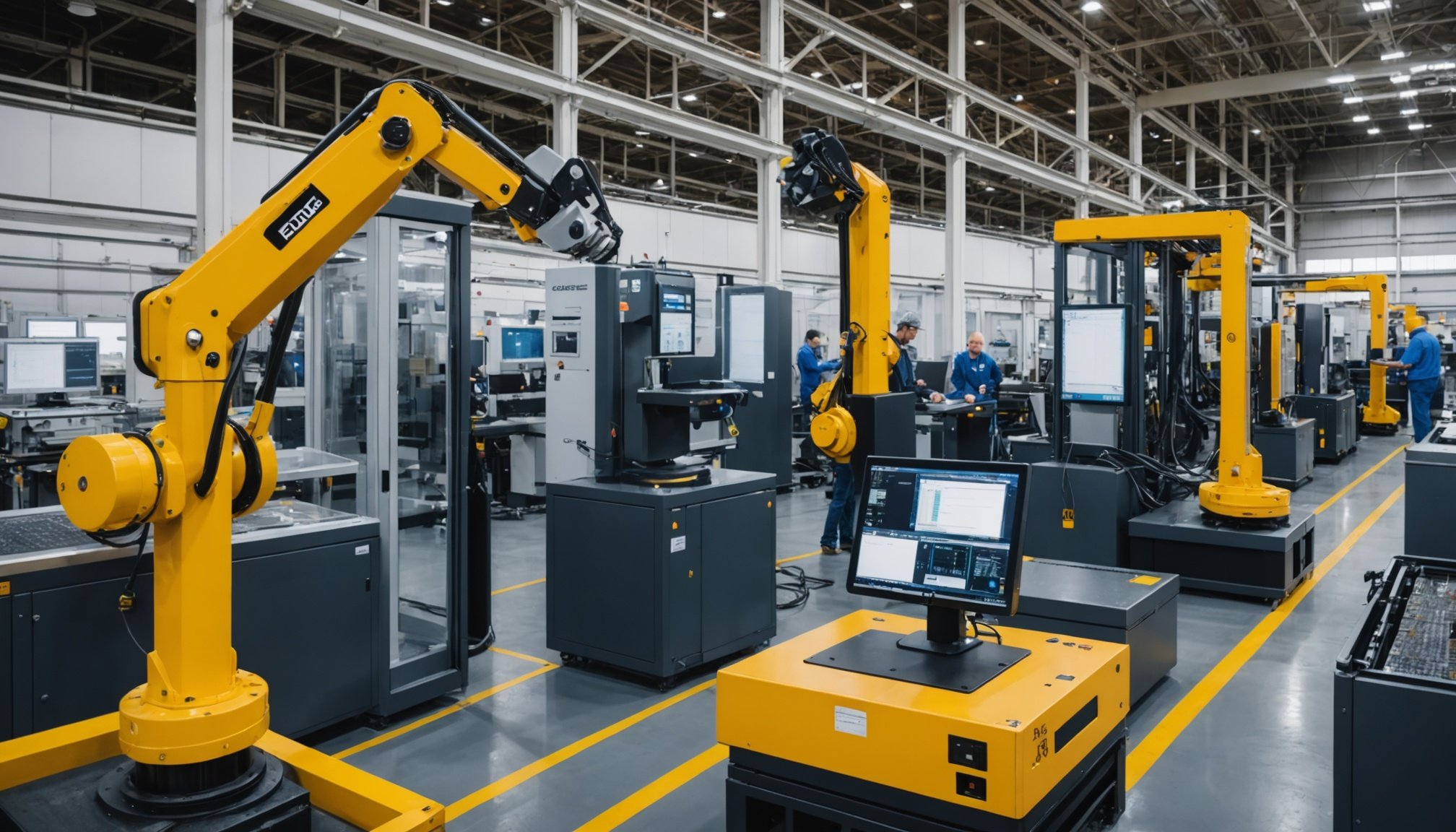Understanding Edge Computing in Smart Manufacturing
In the realm of smart manufacturing, edge computing plays an instrumental role in enhancing efficiency by processing data close to the source. But what exactly is edge computing? At its core, edge computing involves real-time data processing at the edge of the network, near the devices that generate data, rather than routing it to a centralized data center. This method allows for quick response times, crucial in environments where milliseconds can significantly impact productivity and safety.
The importance of proximity in data processing cannot be overstated. By processing data locally, manufacturers can minimize latency, improve decision-making speed, and reduce bandwidth usage. This proximity is particularly beneficial for smart manufacturing, where seamless operations and rapid response to any changes are essential for maintaining efficiency.
In the same genre : Maximize efficiency with dynamic distribution software
When compared to traditional cloud computing models, edge computing stands out for its ability to provide instantaneous insights and actions. While cloud computing centralizes processing power, it often struggles with latency and bandwidth issues, which can hinder manufacturing processes. Edge computing, on the other hand, addresses these challenges by harnessing the power of localized data processing and enabling faster, more reliable data interaction. This approach fosters a more resilient and responsive manufacturing environment, allowing companies to stay competitive in an ever-evolving landscape.
Practical Applications of Edge Computing in Manufacturing
Edge computing is revolutionizing manufacturing by delivering immediate and transformative benefits. Let’s explore its practical applications through several dimensions.
Topic to read : Enhance field productivity with a cmms mobile application
Real-time Monitoring and Predictive Maintenance
Edge computing enables real-time monitoring through the use of IoT devices for continuous data collection on equipment performance. These devices gather vast amounts of data analytics, allowing manufacturers to apply predictive analytics to anticipate equipment failures. This proactive approach helps minimize downtime, increasing productivity and equipment life span.
Quality Control Automation
By implementing edge computing, manufacturers can achieve real-time quality control automation. This means issues in production quality are identified immediately through automated systems, creating useful feedback loops. These feedback loops provide manufacturers with immediate feedback on any defects, allowing for quick corrections and maintaining production efficiency.
Supply Chain Optimization
Edge computing is instrumental in supply chain optimization by informing data-driven decisions. Using industrial IoT systems, it improves real-time inventory management, leading to enhanced supply chain responsiveness. This technology reduces the likelihood of overstock and stockouts, ensuring a steady flow of materials and products. Manufacturers benefit from increased flexibility and customer satisfaction as a result of using data-driven strategies.
Case Studies of Successful Edge Computing Implementations
Exploring real-world applications of edge computing, several leading companies have set benchmarks. These success stories serve as a testament to the tangible benefits of adopting such technology.
A noteworthy example is the automotive industry. Prominent companies are utilizing edge computing to enhance vehicle performance and safety. By processing data closer to the vehicle, these real-world applications facilitate rapid decision-making, crucial for self-driving technology. Case studies indicate improvements in efficiency and cost reduction, solidifying its role in modern vehicles.
In the retail sector, edge computing has empowered businesses with specific outcomes like enhanced customer experiences. Edge solutions allow real-time inventory management, ensuring product availability and efficient operations. This strategy has bolstered customer satisfaction and increased sales, illustrating successful adoption.
Another industry embracing edge computing is healthcare. Real-world applications here include instantaneous patient data processing, leading to improved diagnostic accuracy and personalized treatments. These successful case studies highlight both the potential benefits and challenges overcome, providing valuable lessons for others considering edge solutions.
The key lessons learned from these implementations include the importance of tailoring solutions to industry-specific needs and ensuring robust data security. These strategies have proven critical in driving the success and scalability of edge computing initiatives.
Advantages of Edge Computing in Smart Manufacturing
Edge computing has revolutionized smart manufacturing by offering numerous advantages, including reduced latency, improved decision-making, and enhanced data security. One of the key benefits lies in its ability to process data closer to the source, rather than relying on centralized cloud servers.
Enhanced Data Processing Speeds
By minimizing data transfer times, edge computing dramatically improves response times in manufacturing processes. Manufacturers can experience faster data processing by reducing the distance data must travel. For instance, in automated assembly lines, immediate adjustments can be made to equipment, thanks to near-instantaneous data processing.
Improved Operational Efficiency
Improved decision-making through edge solutions significantly increases operational efficiency. Metrics show noticeable productivity gains as edge computing facilitates better resource allocation. By having real-time access to data, resources can be dynamically adjusted to optimize production flow, reducing downtime and ensuring equipment operates at peak capacity.
Increased Data Security and Privacy
Decentralized data management in edge computing offers increased security, addressing common concerns related to data breaches. With data processed locally rather than being transmitted to centralized servers, the risk of interception is reduced. Edge computing also aids in compliance with strict data privacy regulations by keeping sensitive information closer to its origin point. This local data processing ensures that only anonymized or essential information is transmitted to a central system, enhancing overall data privacy.
Technical Considerations for Edge Computing Deployment
When gearing up for edge computing deployment, the right strategies and infrastructure become crucial. Unlike traditional models, edge computing involves processing data close to its source, mitigating latency issues, and enhancing performance. However, deploying this technology requires several technical considerations to ensure success.
Necessary Infrastructure
First, your deployment strategies must include robust hardware capable of handling real-time data processing demands. This means selecting devices designed for edge environments, which may include sensors, gateways, and edge servers. Scalability is paramount to accommodate potential growth, while connectivity ensures seamless communication across devices.
Key Factors for Success
A well-planned deployment navigates potential pitfalls by considering network bandwidth, power supply reliability, and environmental conditions. Additionally, securing skilled personnel who understand both IT and operational technologies can bridge any knowledge gaps, fostering smoother implementations.
Cybersecurity in Edge Environments
Cybersecurity becomes particularly critical in edge computing. With data processed locally, protecting sensitive information from unauthorized access is of utmost importance. Implementing robust cybersecurity measures ensures data integrity and privacy. These include:
- Data encryption and authentication protocols
- Regular software updates
- Anomaly detection systems
Addressing these cybersecurity challenges at the outset of your deployment strategies sets a foundation for resilience and trust in edge computing environments.
Trends and Future Outlook of Edge Computing in Smart Manufacturing
The landscape of edge computing in smart manufacturing is rapidly evolving with industry trends powered by technological advancements. As manufacturing becomes more sophisticated, understanding these trends and predicting future outlook becomes essential.
The Role of AI and Machine Learning
Integrating Artificial Intelligence (AI) with edge computing allows manufacturers to gather smarter insights, enhancing decision-making processes. AI algorithms process vast datasets at the edge, reducing latency and increasing responsiveness. As industry trends point to increasing reliance on AI, manufacturers can expect to predict market demands with remarkable accuracy, steering their strategies accordingly. AI and Machine Learning (ML) are poised to become even more integral, predicting future trends and driving innovation in manufacturing technologies.
Evolution of Edge Computing Solutions
Emerging tools and technologies continually transform the edge landscape. Industry trends suggest the development of more sophisticated edge solutions capable of real-time data analysis and increased computational power. As forecasting developments indicate, edge computing solutions will become more robust and flexible, adapting to the evolving needs of smart manufacturers.
Regulatory Changes and Compliance Impacts
Understanding and navigating regulatory frameworks is crucial for manufacturers adopting edge computing solutions. As compliance requirements evolve, anticipating these changes becomes a key focus area. Smart manufacturers should strategically plan to overcome compliance challenges, ensuring that edge computing solutions align with industry regulations and are sustainable in the long term.











